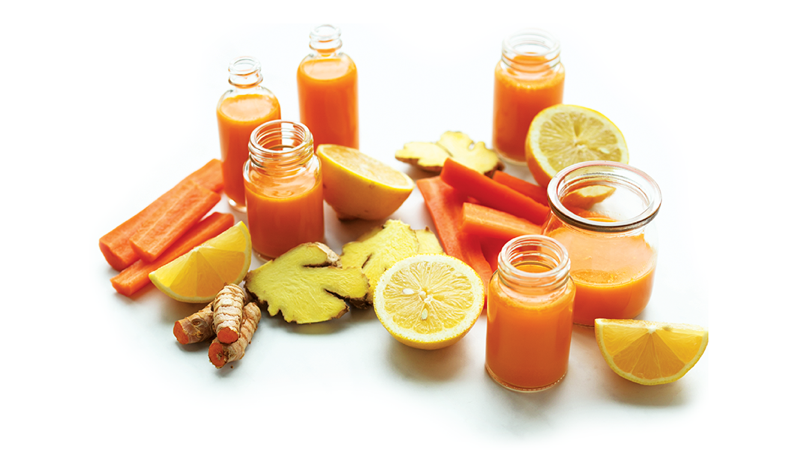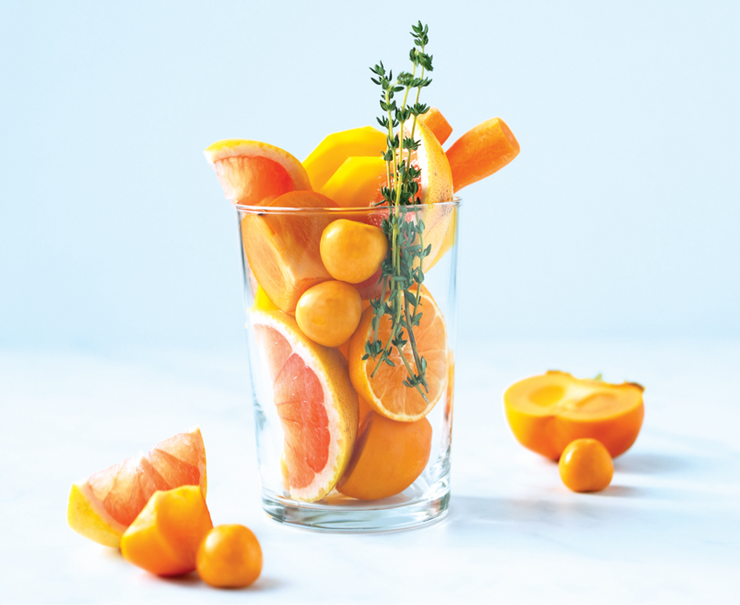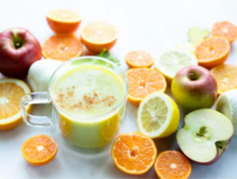Articles
Ready, Set, Refresh
It’s the last month of the year, and with it comes colder temperatures, shorter days, and holiday parties and celebrations. While the weeks leading up to the holidays can be busy, it’s important to honor what’s happening in nature too.
Animals go into hibernation to help cope with colder temps and less fresh food available. While we don’t need to go dormant in the same way, it’s still a time of year to prepare for getting cozy, going inward, and spending more time indoors in a warm atmosphere. Yet, most of us are doing the opposite in December, and it’s no wonder so many people get sick or feel exhausted by the time January rolls around.
Winter is a time to work on conserving your energy rather than expending it. Think about plants and trees. They let their roots grow throughout the autumn season so that they can survive throughout the winter with nourishment from the ground.
How can you root yourself in these early days of winter so that you can feel nourished throughout the season?
We have a few ideas.

Winter Hydration
First, stay hydrated. It sounds simple but so many people believe you don’t need to drink as much in the wintertime or that the body sweats less. Not true!
The body sweats just as much in cold weather as when it’s warm, but you may not notice it because sweat evaporates faster when it’s cold. The air is also more dry because the cold climate has less humidity, and that can easily lead to dehydration.
If you’ve ever been out all day and forgot your water bottle, you might have felt irritated and not yourself. A 2015 study that tracked mood and water intake among healthy women, found that lower water intake was associated with greater tension, depression, and confusion. [1] Research shows that feeling anxious can cause you to sweat more and dehydrate more easily.[2] Dehydration can also lead to physical ailments like headaches, fatigue, and weakness.[3] By prioritizing drinking more water, tea, and juice, you can keep yourself feeling good.
One of the easiest ways to stay hydrated is to track your water intake and aim to drink at least 64 ounces or more, especially if you are active throughout the day. Carrying a refillable water bottle with you can help you remember your progress and remind you to keep sipping water.
If you start to feel the symptoms of dehydration (such as dry mouth or low energy), you may want to replenish with electrolytes. Electrolytes are essential minerals such as sodium, potassium, and magnesium. They help with many bodily functions including balancing blood pH and blood pressure, helping fix tissue damage, regulating nerve and muscle function, and more.
Fresh juices containing ingredients like beets, cherries, spinach, or kale are naturally full of electrolytes. Coconut water also contains potassium, calcium, sodium, and magnesium. [4]
Both water and juice also keep your skin hydrated from the inside out and can help you combat dry skin that occurs in the wintertime.

Grounding Foods
Another way to feel more rooted this time of year is with your food choices. Yes, certain foods and spices can help you feel calm, connected, and grounded.
“Sprouting downward from the seed, the root turns away from the light burrowing deeper and deeper in the cool, moist, earth,” writes Annemarie Colbin about roots in her book Food and Healing. “It anchors the upward-growing shoot, drawing nourishment from the soil and sending it toward the sky. It represents stability and strength.”
Some examples of root vegetables include carrots, parsnips, turnips, celery root, and rutabaga. There are also roots used as condiments or sides such as radishes, onions, garlic, daikon, ginger, and horseradish. Colbin notes that these roots are especially helpful in helping clear up congestion and excess mucus.
Adding grounding foods to your juices like radish, ginger, turmeric, and other root vegetables like carrots and parsnips can be a great way to winterize your juice routine. Many of these ingredients will help warm up your juices and offer you many nutritional benefits for the season.
You can also try making this Winter Wellness Shot that features a few roots. A “wellness shot” is a condensed version of a fresh pressed juice that provides a quick burst of important nutrients.
 Winter Wellness Shot
Winter Wellness Shot
Ingredients:
- 1 lemon
- 6 large carrots
- 1-inch piece fresh turmeric*
- 2-inch piece fresh ginger
- Dash of black pepper
How to Make This Wellness Shot:
Juice the lemon, carrot, turmeric, and ginger. Pour juice into shot glasses or small glassware and add the black pepper on top. If you want more volume to make a 16-ounce juice, add 2 oranges or 2 apples. You can also warm up this shot by mixing it with water from your kettle at the same temp you would use to make herbal tea.
Another way to warm up your juices is to mix them with your favorite winter teas. Try half matcha green tea with half of your favorite green juice recipe. Or mix chamomile tea with an apple, carrot, and beet juice. Both teas and juices are hydrating and combining herbs with juices will add extra nutrition to your winter drinks.
You can make your own nut milk in the winter, like this recipe for almond milk. Almonds, cashews, and pumpkin seeds are all great sources of magnesium, which is a mineral known to help the body relax.[5] In fact, processed foods have been largely stripped of magnesium so if you’ve been eating less whole foods this season, you might want to prioritize foods that are higher in magnesium like nuts, seeds, spinach, beet greens, black beans, and dark chocolate.
Combine homemade almond or cashew milk with chia seeds to make a breakfast pudding that’s full of magnesium, as well as iron, potassium, calcium, omega-3 fatty acids, and antioxidants that will help balance your blood sugar.
To make chia seed pudding, combine 2 tablespoons of chia seeds with ½ cup of your favorite milk and give it a stir. It usually takes about an hour for the pudding consistency to come together, so let it sit in the fridge or make it the night before. For a faster result, add ¼ cup of boiling water to the seeds and then add the milk. You can top your pudding with fresh or frozen fruit, nuts, honey, maple syrup, a natural jam, or any other toppings you like.

Calming Practices
At the end of the month, on December 26, there’s a full moon, known as the Cold Moon in the Old Farmer’s Almanac, which is a Mohawk name that conveys the frosty temperatures this time of year.[6] The time leading up to a full moon can often make people feel moody, sensitive, or fatigued. Combine that with all the holiday hoopla and you might need to find ways to center and calm down within the season.
Take some time when you can to pause and ask yourself how you are feeling both physically and mentally. Tuning into your feelings can help you stay grounded. The full moon is a great time to look inward. Some full moon activities that can help you recharge include:
Journaling
A full moon is a great time to write down goals or wishes you have for the upcoming month. If you are feeling unsettled, journaling can help you explore those feelings. Expressing yourself with writing can help you identify what parts of life have been hard and offer clarity for what you want.
Take a Moon Bath
A moon bath is simply a way to bask in the moonlight and enjoy the natural world. Put on a cozy sweater and coat and get outside to enjoy the hue of the moon. Its gentle glow can have a calming effect. You can either take a slow walk or stand on your porch and tune into the outside air and the moonlight.
Savor Something
In this season, so full of excess, take a moment to enjoy your senses. Use a cookie or a warm tea to take small bites or sips, letting yourself fully engage in the moment. Notice how the cookie or tea tastes and smells, and let the flavors linger in your mouth for as long as you can.
Other grounding techniques can help you focus on the present moment and feel centered throughout the month. Grounding is a way to feel more calm and peaceful in your body as well as in time and space.
For example, if the lack of light or dropping temperatures leaves you feeling moody or fatigued, just start by noticing and acknowledging how you are feeling.
Headspace Meditation and Mindfulness Teacher Dora Kamau, describes how you can allow your feelings and thoughts to float on by, like a feather touching a balloon, rather than focusing on the negative thoughts in this mindfulness visualization. In meditation, you can make a mental note of those thoughts and feelings without labeling the feelings as good or bad. The practice isn’t about letting go of these feelings completely but rather learning how to live with them.
Final Thoughts
Winter's harsh conditions can be challenging to embrace, so it can be helpful to focus on what brings you joy this time of year: a quiet morning after a fresh snowfall, the simple pleasure of home baking, sitting by a fire with cozy socks and a good book. Let yourself find those moments of peace amidst a busy time.

Our Favorite Produce Available in December
Here’s our guide to some of the best seasonal fruits and vegetables this season. Remember: seasonal foods will vary depending on where you live, soil conditions, and weather.
5 INGREDIENTS TO JUICE IN DECEMBER

CLEMENTINES
These small, seedless fruits, also known as Halo or Cutie oranges, are easy to peel and packed with vitamin C, making them a great choice for winter citrus.[7] Clementine season gets going in November and December when the trees start producing fruit. They make a wonderful snack on their own and can help sweeten the taste of any juice.
• Shopping Tip: Look for citrus that is shiny, bright, and blemish-free.
• Storage Tip: Keep clementines on the counter out of direct sunlight in a bowl. Avoid the urge to store them in plastic bags, which can make them spoil faster.

CARROTS
These crunchy root vegetables are full of vitamins, minerals, and antioxidants, including vitamins A, C, and K, folate, potassium, lutein, and zeaxanthin.[8] Carrots taste sweeter as the weather gets colder, as growing veggies increase their sugar content, which helps lower its freezing point when growing and protects the plant’s cells.
• Shopping Tip: Look for carrots with even color, and if you choose to buy a big bag of carrots, be sure to avoid any that look too moist inside the bag.
• Storage Tip: Carrots can maintain their crispness and flavor for weeks if you store them in a breathable bag in the crisper drawer of your fridge.

CHICORIES
These cool weather greens are related to lettuces but tend to be heartier and have a more bitter flavor. They include Belgian endive, curly endive, escarole, and radicchio, all of which can be mixed into salads or added to juices for a richer, earthy flavor.
• Shopping Tip: Look for chicories in grocery stores or at farmers’ markets and be sure they look crisp without any brown edges.
• Juicing Tip: Like other greens, keep them in the fridge, unwashed, until you are ready to use them.

FENNEL
A white bulb with a mild, licorice-like flavor, this vegetable contains plenty of essential nutrients including potassium, calcium, and beta-carotene.[9] Fennel is also a good source of vitamin B6, which helps aid in breaking down carbs and proteins into glucose and amino acids.
• Shopping Tip: You want crispy fennel with a bright color in a tightly packed bulb. Avoid any fennel that is brown, bruised, or feels soft to the touch.
• Storage Tip: Store in the fridge and if you like, cover it with a moist towel. If you notice a little wilting on the outer layers, just peel them off and enjoy the inner parts of the bulb.

PERSIMMONS
This delicious fall fruit is often overlooked for seasonal apples and pears, but if you come across ripe persimmons at your local farmers’ market or grocery store, you should give them a try. They look almost like an orange-colored tomato and may feel quite firm as you squeeze them. The peel is edible, and the inside of a ripe persimmon will taste quite sweet.
• Shopping Tip: When shopping, avoid bruised or lopsided fruit. Color is important. Always choose orange or yellow hued fruit and avoid a green, bitter persimmon.
• Storage Tip: Store them in the fridge to prolong their life, as they should be ripe when you bring them home.
-v1702421726434.png)
Juicing Tips
from Cindy Lafalaise
1. What are your favorite winter juice ingredients and why?
Some of my favorite winter juice ingredients are pomegranate, apples, rosemary, and ginger. Apart from being absolutely delicious, I like to take full advantage of pomegranate this season because they are ripe, and extremely affordable. Apples are just as versatile and I like to add them to most of my recipes and during the holidays.
2. What are some practices that help you stay grounded?
I just had a baby 2 months ago so my practices have changed a bit, but right now I’m very big on my self-care morning routine. I like to wake up earlier than my baby and my husband and while the house is quiet it’s the perfect time to have some me time. I’ll have my morning tea, pray, read, meditate and really pour into me before I have to take care of my family and my clients. Some mornings I will just sit in silence and just center myself before I have to get in mommy, wife, and boss mode.
 INSPIRING NONPROFIT TO KNOW ABOUT
INSPIRING NONPROFIT TO KNOW ABOUT
Each month, we celebrate an inspiring nonprofit that makes fruits and vegetables more accessible to everyone.
Food Literacy Center
Based in Sacramento, California, the Food Literacy Center has a mission to inspire kids to eat their vegetables by teaching children in low-income elementry schools cooking, nutrition, gardening, and active play to improve our health, environmet, and economy.
sources:
- https://www.ncbi.nlm.nih.gov/pmc/articles/PMC6356561
- https://www.ncbi.nlm.nih.gov/pmc/articles/PMC6356561
- https://my.clevelandclinic.org/health/treatments/9013-dehydration
- https://fdc.nal.usda.gov/fdc-app.html#/food-details/1100594/nutrients
- https://pubmed.ncbi.nlm.nih.gov/27933574
- https://www.almanac.com/full-moon-december
- https://fdc.nal.usda.gov/fdc-app.html#/food-details/168195/nutrients
- https://fdc.nal.usda.gov/fdc-app.html#/food-details/170393/nutrients
- https://fdc.nal.usda.gov/fdc-app.html#/food-details/169385/nutrients
- Choosing a selection results in a full page refresh.
- Press the space key then arrow keys to make a selection.



